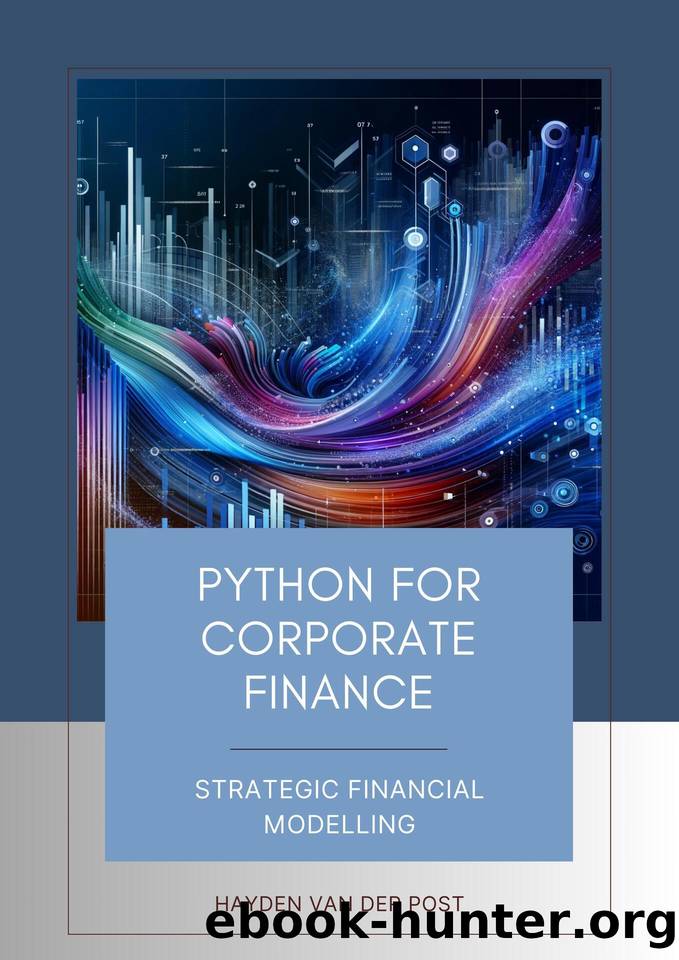Python for Corporate Finance: Strategic Financial Modelling: A Comprehensive guide to Financial modelling with Python by Van Der Post Hayden

Author:Van Der Post, Hayden
Language: eng
Format: epub
Publisher: Reactive Publishing
Published: 2023-11-23T00:00:00+00:00
Building and Implementing Models for Expected Returns and Risks: Capital Asset Pricing Model (CAPM) and Modern Portfolio Theory (MPT) Using Python
Building upon the foundational knowledge of historical data analysis, we now turn our attention to the theoretical frameworks that underpin much of financial investment strategy: the Capital Asset Pricing Model (CAPM) and Modern Portfolio Theory (MPT). These models are instrumental in our understanding of the relationship between expected return and risk. In the vibrant ecosystem of Python, these once complex and cumbersome calculations become streamlined, enabling financial analysts to build and implement these models with precision and ease.
The CAPM is a cornerstone of financial economics that describes the relationship between systematic risk and expected return for assets, particularly stocks. It is predicated on the concept of the market portfolio, a fully diversified portfolio that represents the entire marketâs risk and return profile. The CAPM asserts that the expected return of an asset is proportional to its market risk, as measured by beta (β), which represents the tendency of the asset's returns to respond to swings in the market. In Python, we can calculate an asset's beta by regressing its returns against market returns using the statsmodels library. With the beta value in hand, the
CAPM formula \( E(R_i) = R_f + β_i(E(R_m) - R_f) \) â where \( E(R_i) \) is the expected return of the investment, \( R_f \) is the risk-free rate, and \( E(R_m) \) is the expected return of the market â allows us to estimate the expected return on a stock given its risk profile.
Moving forward, MPT expands on the concept of risk and return to optimize asset allocation within a portfolio. The theory suggests that investors can construct an 'efficient frontier,' a set of optimal portfolios offering the highest expected return for a defined level of risk. Python's scipy library is particularly suited to tackling this optimization problem. By defining the objective function â typically the portfolio's variance â and the constraints â like the desired return or the sum of the weights equaling one â we can employ scipy's optimization functions to find the weights of the assets that minimize risk for a given return, or maximize return for a given risk level.
To implement MPT in Python, we begin by calculating the expected returns and covariance matrix of the asset returns, which we've already learned to compute using pandas and NumPy. With these inputs, we can set up and solve the optimization problem using scipy. The resulting weights tell us how to allocate funds across the portfolio to sit on the efficient frontier. Python's visualization libraries, such as matplotlib and seaborn, can then be used to graphically represent the efficient frontier, making the abstract concept tangible and the strategic implications clear.
Let us consider a scenario where a financial analyst is tasked with optimizing a portfolio of equities. By applying Python's computational prowess to MPT, the analyst can not only deduce the optimal asset mix that minimizes volatility but also explore how changes to individual asset weights affect the portfolio's overall risk and return profile.
Download
This site does not store any files on its server. We only index and link to content provided by other sites. Please contact the content providers to delete copyright contents if any and email us, we'll remove relevant links or contents immediately.
The Mikado Method by Ola Ellnestam Daniel Brolund(20604)
Hello! Python by Anthony Briggs(19899)
Secrets of the JavaScript Ninja by John Resig Bear Bibeault(18208)
Dependency Injection in .NET by Mark Seemann(18109)
The Well-Grounded Java Developer by Benjamin J. Evans Martijn Verburg(17576)
OCA Java SE 8 Programmer I Certification Guide by Mala Gupta(17422)
Kotlin in Action by Dmitry Jemerov(17185)
Adobe Camera Raw For Digital Photographers Only by Rob Sheppard(16934)
Algorithms of the Intelligent Web by Haralambos Marmanis;Dmitry Babenko(16236)
Grails in Action by Glen Smith Peter Ledbrook(15390)
Sass and Compass in Action by Wynn Netherland Nathan Weizenbaum Chris Eppstein Brandon Mathis(13266)
Secrets of the JavaScript Ninja by John Resig & Bear Bibeault(11382)
A Developer's Guide to Building Resilient Cloud Applications with Azure by Hamida Rebai Trabelsi(10580)
Test-Driven iOS Development with Swift 4 by Dominik Hauser(10393)
Jquery UI in Action : Master the concepts Of Jquery UI: A Step By Step Approach by ANMOL GOYAL(9389)
Hit Refresh by Satya Nadella(9085)
The Kubernetes Operator Framework Book by Michael Dame(8522)
Exploring Deepfakes by Bryan Lyon and Matt Tora(8348)
Robo-Advisor with Python by Aki Ranin(8294)
